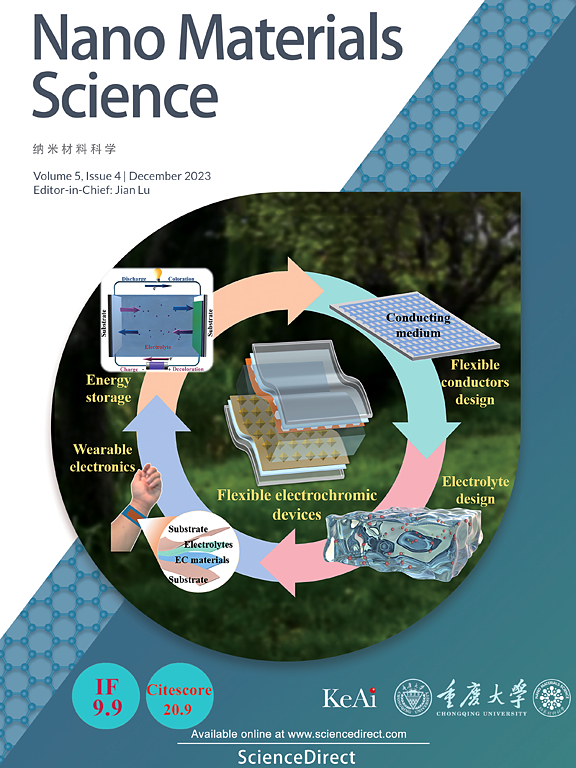利用有缺陷的氧化镁层设计具有定制叶状和多面体结构的多功能 Co-MOF 混合材料,以获得最佳电化学和光催化活性
IF 17.9
2区 材料科学
Q1 Engineering
引用次数: 0
摘要
金属有机框架(MOF)与无机层的杂化将导致新型杂化材料的发现,从而为增强其光催化和电化学响应提供了一种令人信服的策略。本研究利用等离子电解氧化(PEO)在 AZ31 Mg 合金上形成的缺陷层作为 Co-MOF 的成核和生长场所,开发了一种高效的多功能杂化材料。通过改变有机连接剂 2-甲基咪唑(2,MIm)和作为 Co2+ 离子源的硝酸钴的浓度来控制 Co-MOF 的生长。较低浓度的 2,MIm 配体有利于通过各向异性的二维生长形成叶状 MOF 结构,而较高浓度的 2,MIm 配体则会导致快速的各向同性成核,并形成多面体 Co-MOF 结构。以多面体 Co-MOF 结构为特征的样品表现出卓越的电化学稳定性,具有最低的腐蚀电流密度(3.11 × 10-9 A/cm2)和最高的顶层电阻(2.34 × 106 Ω cm2),并具有出色的光催化效率,对模型废水中的有机污染物亚甲基蓝的降解率高达 99.98%。为了评估 Co-MOF 的活性吸附位点,研究人员采用了密度泛函理论(DFT)。本研究探讨了 Co-MOF 涂层的形态随溶液浓度的变化而变化,从而在金属基底上形成具有增强性能的涂层,这为开发具有多种应用的下一代多功能框架奠定了基础。本文章由计算机程序翻译,如有差异,请以英文原文为准。
Utilizing a defective MgO layer for engineering multifunctional Co-MOF hybrid materials with tailored leaf-like and polyhedral structures for optimal electrochemical and photocatalytic activities
The hybridization of metal-organic framework (MOF) with inorganic layers would lead to the discovery of novel hybrid materials that can provide a compelling strategy for enhancing its photocatalytic and electrochemical response. In the present study, a highly efficient multifunctional hybrid material was developed by exploiting the defective layer formed on AZ31 Mg alloy through plasma electrolytic oxidation (PEO) as a nucleation and growth site for Co-MOF. The concentrations of the organic linker 2-Methylimidazole (2,MIm) and cobalt nitrate as a source of Co2+ ions were varied to control the growth of the obtained Co-MOF. Lower concentrations of the 2, MIm ligand favored the formation of leaf-like MOF structures through an anisotropic, two-dimensional growth, while higher concentrations led to rapid, isotropic nucleation and the creation of polyhedral Co-MOF structures. The sample characterized by polyhedral Co-MOF structures exhibited superior electrochemical stability, with the lowest corrosion current density (3.11 × 10−9 A/cm2) and the highest top layer resistance (2.34 × 106 Ω cm2), and demonstrated outstanding photocatalytic efficiency, achieving a remarkable 99.98 % degradation of methylene blue, an organic pollutant, in model wastewater. To assess the active adsorption sites of the Co-MOF, density functional theory (DFT) was utilized. This study explores the changes in morphologies of the coatings of Co-MOF with the change of solution concentration to form coatings with enhanced properties on the metallic substrate, which could establish the groundwork for the development of next-generation multifunctional frameworks with diverse applications.
求助全文
通过发布文献求助,成功后即可免费获取论文全文。
去求助
来源期刊

Nano Materials Science
Engineering-Mechanics of Materials
CiteScore
20.90
自引率
3.00%
发文量
294
审稿时长
9 weeks
期刊介绍:
Nano Materials Science (NMS) is an international and interdisciplinary, open access, scholarly journal. NMS publishes peer-reviewed original articles and reviews on nanoscale material science and nanometer devices, with topics encompassing preparation and processing; high-throughput characterization; material performance evaluation and application of material characteristics such as the microstructure and properties of one-dimensional, two-dimensional, and three-dimensional nanostructured and nanofunctional materials; design, preparation, and processing techniques; and performance evaluation technology and nanometer device applications.
 求助内容:
求助内容: 应助结果提醒方式:
应助结果提醒方式:


